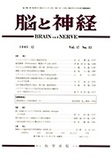Japanese
English
- 有料閲覧
- Abstract 文献概要
- 1ページ目 Look Inside
発症後7日以内に検査しえた急性期脳血管障害13例の経時的な脳波所見について検討を行ない,実験的脳血管障害の脳波の知見と対比させて考察した。
1)中大脳動脈およびその分枝の閉塞による脳軟化では,患側に明瞭な高振幅徐波を認めたが,対側での異常はごく軽度であり,一側性の脳波異常を示した。
内頸動脈閉塞による脳軟化の場合は,3例中2例に両側性異常を認めた。
2)脳出血では全例に両側性の脳波異常を認めた。発症後2日以内ではθ波を主体とした変化が多く,著明な徐波は発症3日以後のものに多く見られ,脳波像を発症よりの時閻経過との関連でとらえることの必要性が示唆された。
3)急性期における対側の脳波異常の有無は,これら疾患の鑑別のうえで重要な意義をもつものと考えられた。また,脳波異常の推移を経時的にとらえることは,病状の推移を知り,予後を判定するうえで有益であり,とくに両側性の低電位傾向の進行は予後の不良を示すものと考えられた。
In 13 patients, EEG were examined within a week after the stroke of cerebrovascular diseases; 7 cases of cerebral hemorrhage and 6 cases of cerebral infarc-tion. The following results were obtained.
1) In all cases of cereblal hemorrhage, the record showed universal irregular slow activity, more pro-nounced on the affected side in general. In massive cerebral hemorrhage with ventricular rupture, severe voltage depression were obtained invariably in bilateral hemisphere.
2) In extensive cerebral infarction, prominent slow activity was observed on the affected side, without significant contralateral abnormalities. However, bi-lateral abnormalities were observed in patients with carotid occlusion.
In most cases, the contralateral abnormality seems to be a useful information concerning the differential diagncsis of these diseases. In addition, emphasis was placed upon the serial correlated studies as an aid in prognosis of cerebrovascular diseases.

Copyright © 1965, Igaku-Shoin Ltd. All rights reserved.


